| Article ID | Journal | Published Year | Pages | File Type |
|---|---|---|---|---|
| 4389411 | Ecological Engineering | 2014 | 9 Pages |
•Abundance of dinoflagellate species and their toxicity in shellfishes.•HABs were sporadic and not correlated with the toxicity in shellfishes.•Dinoflagellate distribution and toxin production are responsible of this result.
The dynamic of three potentially toxic dinoflagellate genera (Alexandrium spp., Prorocentrum spp., and Dinophysis spp.) and one diatom genus (Pseudo-nitzschia spp.) were studied in the Bizerte Lagoon (Tunisia) over a 5-year period (from 2007 to 2011) and sampled at four sites. Concomitantly, the toxicity of three biotoxin groups, DSP (diarrheic shellfish poisoning), PSP (paralytic shellfish poisoning) and ASP (amnesic shellfish poisoning) were measured in both mussels and oysters collected on farms corresponding to the sampled sites. No correlations between phytoplankton abundances and PSP and DSP toxicity were found in either mussels or oysters, despite toxicity occurrence recorded on or just after the sampling dates. Several hypotheses may explain these results: (i) spatial heterogeneity of dinoflagellate distribution may lead to difficulties in quantitatively assessing harmful algae abundance, (ii) toxin production may not be associated exclusively with phytoplankton abundance, and (iii) mussel or oyster toxicity may better reflect the toxin environment than punctual samplings. Our results support the highly unpredictable nature of blooms and the associated toxicity of HABs. This suggests that monitoring for shellfish safety should include both toxigenic species determination and enumeration along with the use of shellfish as sentinels and bio-integrators of toxins.
